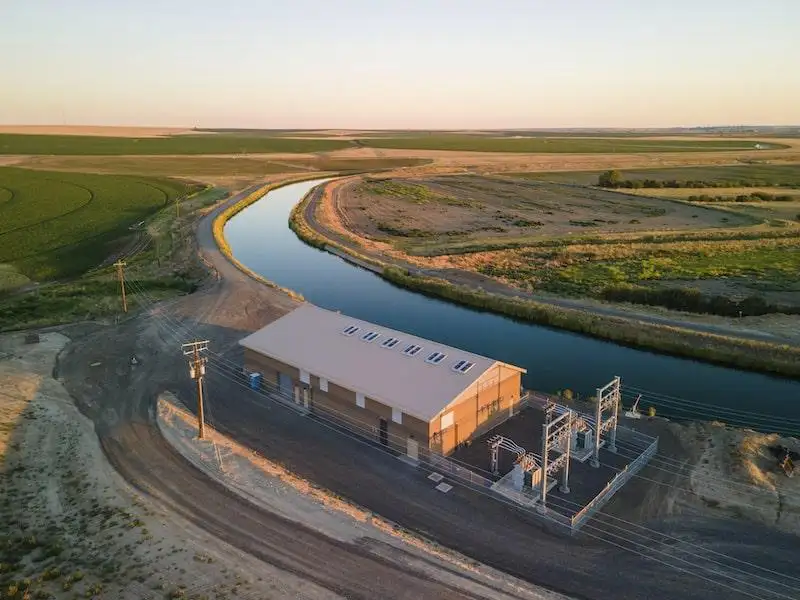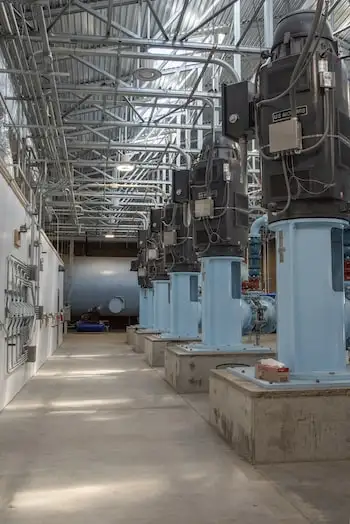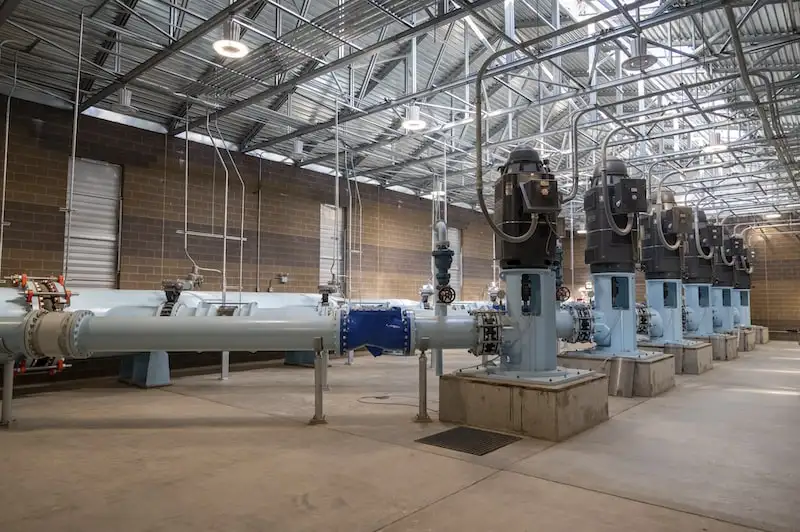Website: https://www.wwdmag.com/pumps/pumps-washington-project-pack-punch

Odessa Groundwater Replacement Project Overview
The first pump station of the Odessa Groundwater Replacement, called EL47.5, became operational in the spring of 2021. The project includes nearly nine miles of pipes and will provide water to roughly 10,500 acres of valuable farmland that are currently served by deep wells.
Those wells, however, are rapidly depleting. According to the U.S. Bureau of Reclamation, more than 700 wells have drawn water from the Odessa Aquifer. Some of the wells have reached depths as far as 2,400 feet, and groundwater has dropped more than 200 feet. As the groundwater supply diminished, local farmers and homeowners drilled deeper into the earth to reach the diminishing water supply.

The Pumps for the Pump Station
At the heart of the system of EL47.5 are the pumps. Five pumps have 1,250 horsepower, and another has 700 hp. For a reference point, the average horsepower of automobiles is between 180-200, while some SUVs exceed 300 hp.
The six pumps in EL47.5 combine for 6,950 hp, and can deliver up to 63,000 gallons per minute to replenish groundwater in one of the nation’s most critical farming regions.
The First of Nine Pressurized Pipeline Systems
EL47.5 is the first of nine proposed pressurized pipeline systems being built to deliver Columbia Basin Project surface supplies to replace groundwater use on 87,000 acres across Grant, Adams and Lincoln counties.
“Water is ordered daily, conveyed through the East Low Canal and delivered on a 24-hour basis,’’ Vicky Scharlau, Executive Director of the Columbia Basin Development League, said. “The water is sent down the canals and the pumping station is just one of many outlets that takes water from the canal and distributes it to the different lands.”
Construction on the $20.8 million project started in 2016, and was redesigned in 2017 to 2018 after a grant allowed for additional capacity. Construction was completed in late summer 2020 and became operational in the spring of 2021.
EL47.5 includes 9 miles of pipes ranging in 14 to 60 inches in diameter with 15 turnouts. Water delivery ranges from 7 to 140 cubic feet per second with a total dynamic head ranging from 250 to 345.
As the first pumping station in the Odessa Groundwater system, teams faced a series of challenges that hopefully will be reduced in subsequent stations.
“Regulations, costs and easement issues were overcome by time and perseverance,’’ Scharlau said. “Along with typical construction issues. Once it was designed, construction was pretty smooth. The pandemic occurred during construction of the plant, and that certainly didn’t help.”
Vast Intake Structure
The 12,800 square-foot pump station holds the pumps and pipes that distribute the water. The intake structure includes a sump that is 35 feet to 86 feet wide, 80 feet long and 18 feet deep. It includes 820 cubic yards of concrete and 145,000 pounds of rebar.
Installing and accessing the pumps when they eventually need replacement was one of the important design considerations in the station’s construction.
Hatches, Domes & Doors
Teams will access the pumps through six roof hatches manufactured by The Bilco Company. The custom hatches, 6-feet-6-inches by 7-feet, are fabricated with polycarbonate dome covers for natural daylight and engineered lift assistance for easy, one-hand operation. They are also modified for hand winch operation, allowing them to be easily opened and closed from inside the building.
The aluminum hatches, which were supplied by Anderson Specialties, were custom-fabricated to meet unique size requirements.
“They were proposed by the contractor and met the specs that we required,’’ said Jon Erickson of the East Columbia Basin Irrigation District and project manager of the Odessa Groundwater Replacement Project. “They were also important because they allowed pump and motor access by crane.”
“This is the first pumping plant in the project and the lands that it serve is what makes this pump station unique,’’ Erickson said. “This is an important step in getting water to the farmers that need it.”
The ECBID designed the pumping station, which was built by Goodman & Mehlenbacher Enterprises, Inc.

Hatches, Domes & Doors
Water is a precious resource in every community, but it is especially critical in Odessa. In Washington, agriculture generates an economic impact of $49 billion and employs over 160,000 residents.
In Lincoln County, wheat farming contributes more than $300 million to the local economy. Annual wheat product often exceeds 25 million bushels, ranking second nationally behind only nearby Whitman County.
While the county’s population is small – the region has fewer than 11,000 residents – farming is huge. There are 783 farms, operating on more than 1.1 million acres. According to the United States Department of Agriculture and its 2017 census, 383 of the farms are more than 1,000 acres.
Groundwater is also essential because the region does not receive much rain. Lincoln County only receives 14 inches per year, while the national average is 38 inches.
Given those statistics, the long-term success of the Odessa Groundwater Replacement Program is clearly evident. With aquifer levels rapidly declining, the groundwater replacement project and the powerful pumps that provide the water will play an important role in the region’s economic future. Maybe farmers could have continued to draw water from the aquifer. Maybe, though, the aquifer might eventually go dry. That’s not a chance the region is willing to take.
“It is only speculative what and when would have happened without the project,’’ Scharlau said. “However, trends have shown a consistently declining aquifer.”

